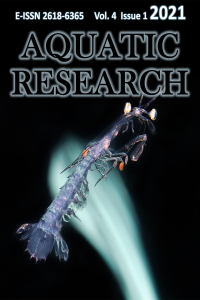
Aquatic Research
Yazarlar: Jhonamie MABUHAY-OMAR, Genese Divine B. CAYABO, Lota A. CREENCIA
Konular:Deniz ve Tatlı Su Biyolojisi
Anahtar Kelimeler:Abalone,Cage culture,Coliform,Microbial load,Most probable number,Salmonella,Vibrio
Özet: Abalone is one of the most highly priced seafood delicacies and prepared in various dishes like breaded, soup, steamed and sashimi. They are susceptible to microbial contamination since it is eaten raw sometimes and pathogenic microorganisms can be hazardous to consumers. The present study was carried out to determine the coliform load and the presence of presumptive pathogenic bacteria in cage-cultured abalone in Taytay, Palawan, Philippines. The study was limited to the detection of coliform and some presumptive pathogenic bacteria in different parts of abalone such as gut, gills and mantle. The result of the study revealed that the count of coliforms present in the mantle and gills of abalone falls within the normal standard limit (7 – 21 MPN 100g-1 sample). On the other hand, the gut of abalone was beyond the standard limit (460 MPN 100g-1 sample). Moreover, the gut of abalone harbors Vibrio spp., Salmonella spp. and Shigella spp. and general enteric bacteria. Foodborne infections caused by Vibrio, Salmonella and Shigella are common in Asia.